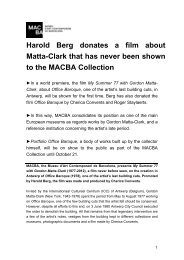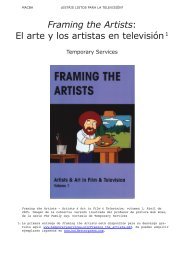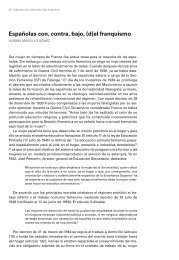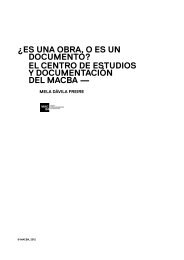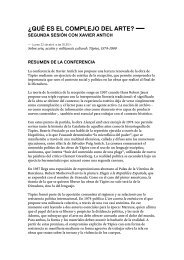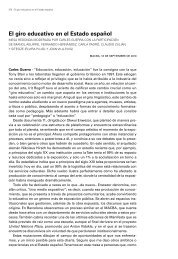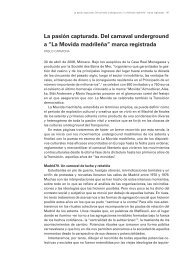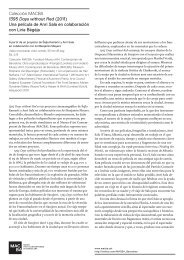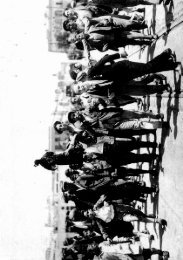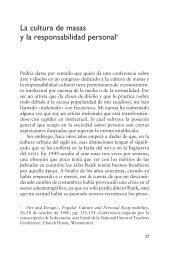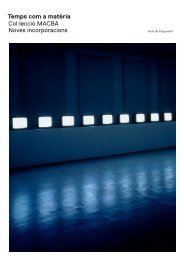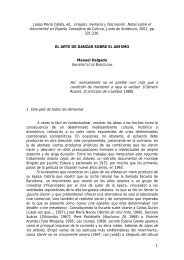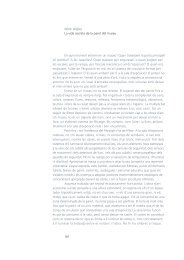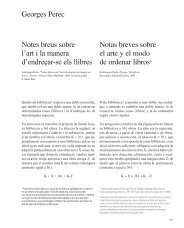Chance, Indeterminacy, Multiplicity - Macba
Chance, Indeterminacy, Multiplicity - Macba
Chance, Indeterminacy, Multiplicity - Macba
You also want an ePaper? Increase the reach of your titles
YUMPU automatically turns print PDFs into web optimized ePapers that Google loves.
74. Cage, “Experimental Music,” p. 12.<br />
75. Ibíd.<br />
76. Bergson, pp. 258–59. Bergson is<br />
discussing life as a virtual, continuous<br />
multiplicity.<br />
Cage advocated promoting such an individualized reception by<br />
dispersing performers and/or loudspeakers around and about the<br />
audience (an avenue first explored in Cage’s happening-like Theater<br />
Event #1 [1952] at Black Mountain College). Such acoustical distribution<br />
fragmented the performed sound, rendering what is heard<br />
by each audience member different from the experience of others<br />
located at different positions throughout the hall. In this way, the<br />
unique proximity of each listener to the various points of sound<br />
production physically renders performance indeterminate of any<br />
one, unique, collective experience of hearing. Cage explained:<br />
Rehearsals have shown that this new music, whether for tape or for instruments,<br />
is more clearly heard when the several loud-speakers or performers<br />
are separated in space rather than grouped closely together. For this music is not<br />
concerned with harmoniousness as generally understood, where the quality of<br />
harmony results from a blending of several elements. Here we are concerned with<br />
the coexistence of dissimilars, and the central points where fusion occurs are<br />
many: the ears of the listeners wherever they are. 74<br />
In this context, immediately following the above quote, Cage once<br />
again referenced Bergson’s discussion of disorder: “This disharmony,<br />
to paraphrase Bergson’s statement about disorder, is simply<br />
a harmony to which many are unaccustomed.” 75<br />
Cage’s process of moving via differentiation through the processes<br />
of composition, performance, and audition figures as an<br />
almost analytical model of Bergson’s ontological vision and is one<br />
of the ways that Cage’s music could be seen to imitate nature in its<br />
“manner of operation.” From the level of the universe as a whole<br />
to that of human society to that of the smallest of microorganisms,<br />
nature was described by Bergson as in a state of ongoing fluctuation<br />
between the two poles of individuation and association:<br />
So, among the dissociated individuals, one life goes on moving: everywhere<br />
the tendency to individualize is opposed and at the same time completed by an<br />
antagonistic and complementary tendency to associate, as if the manifold unity of<br />
life, drawn in the direction of multiplicity, made so much the more effort to withdraw<br />
itself on to itself. A part is no sooner detached than it tends to reunite itself,<br />
if not to all the rest, at least to what is nearest to it. Hence, throughout the whole<br />
realm of life, a balancing between individuation and association. 76<br />
In Cage’s work, the same dual process is at work, as, for instance,<br />
individual notes are actualized from the virtual totality that is all<br />
sound to then find themselves associated with others to form a<br />
virtual multiplicity with regard to performance, and then again<br />
from the process of performance to the situation of hearing. Such<br />
a dual movement of individuation and association (what Cage<br />
229



